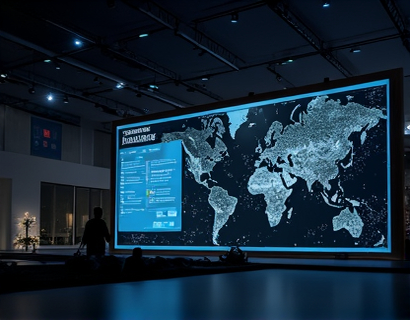Next-Gen QR Code Innovations: Elevating Business and Social Media Engagement for Modern Enterprises
In the rapidly evolving digital landscape, businesses and social media managers are constantly seeking innovative solutions to enhance engagement and streamline interactions with their audience. One such technology that has emerged as a game-changer is the next-generation QR Code, often referred to as enhanced or intelligent QR Codes. These advanced QR Codes go beyond the traditional static barcode, offering customizable and intuitive tools that significantly improve information sharing and customer interaction. This article delves into the transformative impact of these next-gen QR Codes on business and social media engagement, highlighting their features, benefits, and practical applications for modern enterprises.
Understanding Next-Gen QR Codes
Next-gen QR Codes are an evolution of the traditional QR Code, designed to meet the demands of today's digital consumers. Unlike standard QR Codes that primarily store URLs and basic text, next-gen QR Codes can encode a wealth of data types, including text, URLs, images, videos, and even complex data sets. This versatility allows businesses to create more engaging and informative content that resonates with their audience.
The structure of next-gen QR Codes is more sophisticated, incorporating error correction levels that ensure data integrity even when the code is partially damaged. This robustness makes them ideal for use in various environments and conditions, from outdoor advertising to indoor promotional materials. Additionally, these QR Codes can be dynamically updated, allowing businesses to change the linked content without needing to print new codes.
Customization and Personalization
One of the most significant advantages of next-gen QR Codes is their customization potential. Businesses can tailor the appearance of these codes to align with their brand identity, including colors, shapes, and logos. This level of personalization not only enhances the visual appeal but also reinforces brand recognition. For instance, a retail brand can design QR Codes that match their packaging or store decor, creating a seamless and cohesive customer experience.
Moreover, next-gen QR Codes can be programmed to direct users to specific landing pages or interactive experiences based on context. For example, a QR Code placed on a product in a store can lead to a personalized product demo video or a special offer, enhancing the shopping experience and increasing the likelihood of a purchase.
Enhanced User Experience
The user experience is a critical factor in the success of any digital tool, and next-gen QR Codes excel in this area. These codes can be designed to provide instant access to rich media content, such as high-definition videos, 3D models, and augmented reality (AR) experiences. This immediate access to engaging content keeps users interested and engaged, reducing bounce rates and increasing time spent on the linked page.
Furthermore, next-gen QR Codes can be optimized for mobile devices, ensuring a smooth and quick scanning experience. With the majority of internet usage now happening on mobile devices, this optimization is crucial for maintaining user satisfaction and engagement. The fast and reliable performance of these codes ensures that users have a positive interaction, which is essential for building trust and loyalty.
Data Collection and Analytics
Next-gen QR Codes offer advanced data collection and analytics capabilities that provide valuable insights into user behavior and engagement. Businesses can track how many times a QR Code is scanned, where it is being used, and what actions users take after scanning. This data can be used to refine marketing strategies, optimize content, and improve overall customer engagement.
For instance, a brand can use the analytics to determine which products are generating the most interest through QR Codes and adjust their inventory and promotions accordingly. Additionally, by analyzing scan locations and times, businesses can gain insights into consumer patterns and preferences, enabling more targeted and effective marketing efforts.
Social Media Integration
The integration of next-gen QR Codes with social media platforms has opened up new avenues for engagement and interaction. These codes can be used to create seamless transitions between offline and online experiences, enhancing the overall customer journey. For example, a QR Code displayed on a billboard can direct users to a social media challenge or a live Q&A session, encouraging real-time participation and interaction.
Social media managers can also use QR Codes to drive traffic to their profiles or specific posts, increasing visibility and reach. By placing QR Codes on physical events or products, businesses can encourage attendees and customers to share their experiences on social media, creating a viral marketing effect. This not only amplifies brand exposure but also fosters a sense of community and engagement among followers.
Security and Trust
Security is a paramount concern in the digital age, and next-gen QR Codes address this by incorporating advanced security features. These codes can include encryption and authentication mechanisms to ensure that the content linked is safe and trustworthy. This is particularly important for businesses that handle sensitive information or transactions.
By using secure QR Codes, businesses can build trust with their audience, assuring them that their data is protected. This trust is crucial for maintaining customer loyalty and encouraging repeat interactions. Additionally, the ability to verify the authenticity of a QR Code can help prevent fraud and misinformation, further enhancing the credibility of the brand.
Case Studies and Real-World Applications
To better understand the practical benefits of next-gen QR Codes, let's explore some real-world applications across different industries.
In the retail sector, a fashion brand implemented next-gen QR Codes on their product tags. When scanned, these codes directed customers to a virtual try-on feature, allowing them to see how the clothing would look without physically trying it on. This not only enhanced the shopping experience but also reduced return rates and increased customer satisfaction.
In the hospitality industry, a hotel chain used QR Codes on their room keys to provide guests with access to a personalized welcome package, including local attractions, restaurant recommendations, and special offers. This digital touchpoint not only improved guest satisfaction but also increased the likelihood of guests recommending the hotel to others.
In the educational sector, a university used next-gen QR Codes on campus maps to provide students and visitors with interactive information about facilities, events, and resources. This enhanced the user experience and made it easier for newcomers to navigate the campus.
Implementation and Best Practices
For businesses looking to integrate next-gen QR Codes into their strategies, here are some best practices to consider:
- Define Clear Objectives: Determine what you aim to achieve with QR Codes, whether it's increasing website traffic, driving sales, or enhancing customer engagement.
- Choose the Right Content: Ensure that the content linked to the QR Code is relevant, valuable, and aligned with your audience's interests.
- Optimize for Mobile: Given the prevalence of mobile usage, make sure the QR Code and the linked content are mobile-friendly.
- Test and Refine: Conduct tests to ensure the QR Code scans correctly and leads to the intended destination. Use analytics to monitor performance and make adjustments as needed.
- Educate Your Audience: Inform your audience about the benefits of scanning the QR Code and how it enhances their experience. This can be done through signage, instructions, or gentle prompts.
By following these best practices, businesses can maximize the effectiveness of next-gen QR Codes and achieve their engagement goals.
Conclusion
Next-gen QR Codes represent a significant advancement in digital engagement tools, offering businesses and social media managers powerful and flexible ways to connect with their audience. These codes not only enhance the user experience but also provide valuable insights through data collection and analytics. As the digital landscape continues to evolve, embracing next-gen QR Codes can be a strategic move for modern enterprises looking to stay ahead of the curve and foster deeper connections with their audience.










































